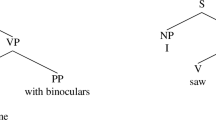Abstract
Inferentialism claims that expressions are meaningful by virtue of rules governing their use. In particular, logical expressions are autonomous if given meaning by their introduction-rules, rules specifying the grounds for assertion of propositions containing them. If the elimination-rules do no more, and no less, than is justified by the introduction-rules, the rules satisfy what Prawitz, following Lorenzen, called an inversion principle. This connection between rules leads to a general form of elimination-rule, and when the rules have this form, they may be said to exhibit “general-elimination” harmony. Ge-harmony ensures that the meaning of a logical expression is clearly visible in its I-rule, and that the I- and E-rules are coherent, in encapsulating the same meaning. However, it does not ensure that the resulting logical system is normalizable, nor that it satisfies the conservative extension property, nor that it is consistent. Thus harmony should not be identified with any of these notions.
Similar content being viewed by others
References
Brandom, R. B. (2000). Articulating reasons. Cambridge, MA: Harvard University Press.
Dummett, M. (1973). Frege: Philosophy of language. London: Duckworth.
Dummett, M. (1991). Logical basis of metaphysics. London: Duckworth.
Dummett, M. (1993). Language and truth. In The seas of language (pp. 117–165). Oxford: Clarendon Press.
Dyckhoff, R., & Francez, N. (2007). A note on harmony. Typescript, August 2007.
Gentzen, G. (1969). Investigations concerning logical deduction. In M. Szabo (Ed.), The collected papers of Gerhard Gentzen (pp. 68–131). Amsterdam: North-Holland.
Lorenzen, P. (1955). Einführung in die operative Logik und Mathematik. Berlin, Göttingen, Heidelberg: Springer.
Meyer, R. K., & Sylvan, R. (2003). Extensional reduction II. In R. Brady, et al. (Eds.), Relevant logics and their rivals (Vol. II, pp. 352–407). Aldershot: Ashgate.
Milne, P. (2002). Harmony, purity, simplicitty and a ‘seemingly magical fact’. The Monist, 85, 498–534.
Moriconi, E., & Tesconi, L. (2008). On inversion principles. History and Philosophy of Logic, 29, 103–113.
Negri, S., & von Plato, J. (2001). Structural proof theory. Cambridge: Cambridge University Press.
Prawitz, D. (1965). Natural deduction. Stockholm: Almqvist & Wiksell.
Prawitz, D. (1979). Proofs and the meaning and completeness of the logical constants. In J. Hintikka, I. Niiniluoto, & E. Saarinen (Eds.), Essays on mathematical and philosophical logic (pp. 25–40). Dordrecht: Reidel.
Read, S. (2000). Harmony and autonomy in classical logic. Journal of Philosophical Logic, 29, 123–154.
Read, S. (2005). The unity of the fact. Philosophy, 80, 317–342.
Read, S. (2008). Harmony and modality. In C. Dégremont, L. Kieff, & H. Rückert (Eds.), Dialogues, logics and other strange things: Essays in honour of Shahid Rahman (pp. 285–303). London: College Publications.
Restall, G. (2005). Multiple conclusions. In P. Hajek, L. Valdes-Villanueva, & D. Westerstahl (Eds.), Logic, methodology and philosophy of science: Proceedings of the twelfth international congress (pp. 189–205). London: Kings College Publications.
Schroeder-Heister, P. (1984). A natural extension of natural deduction. Journal of Symbolic Logic, 49, 1284–1300.
Schroeder-Heister, P. (2004). On the notion of assumption in logical systems. In Philosophy-science-scientific philosophy: Selected papers contributed to the sections of the 5th international congress of the Society for Analytical Philosophy, Bielefeld, 22–26 September 2003 (pp. 27–48). Paderborn: Mentis.
von Plato, J. (2001). Natural deduction with general elimination rules. Archive for Mathematical Logic, 40, 521–547.
von Plato, J. (2008). Gentzen’s proof of normalization for natural deduction. Bulletin of Symbolic Logic, 14, 245–257.
Author information
Authors and Affiliations
Corresponding author
Additional information
This work is supported by Research Grant AH/F018398/1 (Foundations of Logical Consequence) from the Arts and Humanities Research Council, UK.
Rights and permissions
About this article
Cite this article
Read, S. General-Elimination Harmony and the Meaning of the Logical Constants. J Philos Logic 39, 557–576 (2010). https://doi.org/10.1007/s10992-010-9133-7
Received:
Accepted:
Published:
Issue Date:
DOI: https://doi.org/10.1007/s10992-010-9133-7




